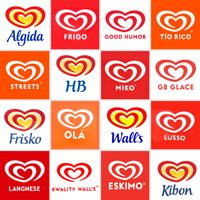Product Range Brand Policy May 16, 2009
Posted by mariobarreiro in Marketing.trackback
Within the Marketing Mix, a very important item that makes up the product is branding. A brand, with its name, design, style, words or symbols, emphasizes a product as a unique article, making it different to customers from other products in the same segment (Brassington & Pettitt, 2003: 275).
One of the concepts that branding strategy develops is the role of the company name and its relationship with the product range. Brassington & Pettitt (2003: 284) call this the “product range brand policy”. The strength of the association between the mother/family/company brand and the product brand has benefits and drawbacks. There are three approaches: discrete branding, monolithic branding and endorsed branding.
Discrete branding
In this case, each product receives and individual/independent name, which is not related to the company name. This strategy has the advantage that the firm can launch several brands to cover each segment of the market. However, it usually means higher marketing costs that can drive to less profitability. Jobber & Fahy (2003: 134) refer to discrete branding as “individual brand name”.
Examples of discrete branding can be found in Cif and Domestos (Procter and Gamble multi-purpose cleaners), Chevrolet, Pontiac or Cadillac (General Motors cars) and Kit-Kat (Nestle, launched by Rowntree in 1935).
Monolithic branding
At the opposite side, under the monolithic approach, the brand uses a family name, normally the company name, followed by a name that identifies the product range. The positive points are that the communication of the company is only one, and the attributes and values of the family brand benefit all brands. Nevertheless, in case of failure of one product, the whole brand will be affected. Monolithic branding is also known as “family brand name” or “umbrella branding” by Jobber & Fahy (2003: 134).
Several companies use this strategy. BMW precedes the model number of each car to build every name (BMW X3, BMW Z4, BMW M5). The Virgin Group companies have ‘Virgin’ at the beginning of every name (Virgin Atlantic, Virgin Balloon Flights, Virgin Megastore USA).

Virgin Companies.
Source: http://www.virgin.co.uk/home.aspx
Moreover, many technology corporations nowadays follow this approach:
– Microsoft: Microsoft Windows, Microsoft Office, Microsoft Encarta.
– Google: Google Mail, Google Chrome, Google Earth.
– Apple with its ‘i’: iTunes, iPod, iPhone, iBook.
Endorsed branding
This is suited between the monolithic and discrete branding. The endorsed approach uses the family name and the individual product name, which is the dominant. There are two different ways to apply it: fixed endorsed and flexible endorsed.
On one hand, in the fixed endorsed there is a rigid relationship between the company name and the product brand. For instance, Ford does it with models such as Mustang. It is referenced by people using either the model brand or the whole name (Mustang or Ford Mustang).
On the other hand, the flexible endorsed gives more freedom to the brand. For example, the Unilever division of Ice creams, Heartbrand, contains brands such as Magnum, Cornetto or Solero. All of them include the Heartbrand logo, but they have their own marketing campaigns and target markets. Furthermore, this could be understood as a third level. In the middle, there is the name of the local brand on each country, covered by the umbrella of the Heartbrand logo. Thus, what for the British customers is Wall’s, for the Spanish ones is Frigo, or Olá for the Portuguese.
Unilever –> Heartbrand logo with local brand name –> Final independent products

Unilever Heartbrand logos.
Source: http://www.cidadedoslogos.com/news/index.php/2008/04/02/o-heartbrand-da-unilever/
 Heartbrand independent Brands.
Heartbrand independent Brands.
Source: http://www.walls.co.uk/uk_en/products/default.aspx
The main benefit of endorsed branding is the brand credibility, although as well as discrete branding, it uses to generate higher marketing costs.
Web Articles:
- Warren Allan Johnson. 2005. All Branding is Divided into Three Parts. [online]. Unsolicited Marketing Advice Blog. Available from: http://www.unsolicitedmarketingadvice.com/2005/12/all-branding-is-divided-into-three.html [accessed 12 February 2009]
Books:
- F. Brassington and S.Pettitt. 2000. Principles of Marketing. 2nd ed. Prentice Hall
- D. Jobber and J.Fahy. 2003. Foundations of Marketing. McGraw-Hill Education
can you help me please?
what is range branding ? I can not understand it please explain with examples
Thanks
Exactly what I was looking for, thanks for posting.
I think the admin of this web site is in fact working hard in support of his
website, for the reason that here every information is quality based information.
Simplified, good quality information! Thank you.